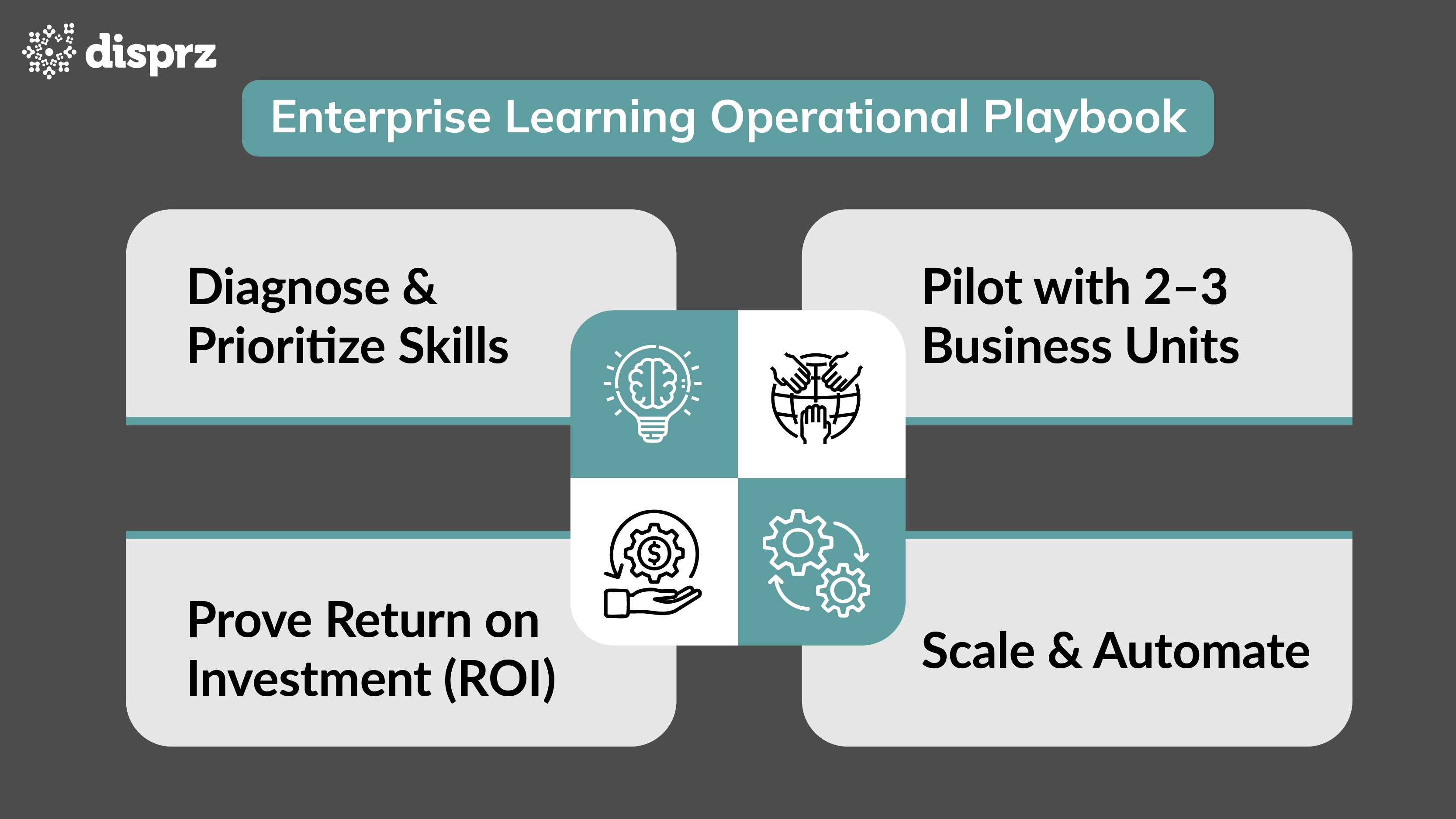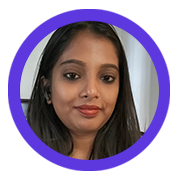Learning and Development (L&D) leaders today are under growing pressure to show that training leads to real business results. Yet many programs still focus on attendance and completion rather than performance. As a result, a large share of employees receive training that doesn’t match their roles or growth needs.
Over the next five years, AI is expected to create 11 million new jobs globally while displacing 9 million others, meaning organizations can no longer afford disconnected learning. They need systems that continuously reskill their workforce in line with shifting job realities.
To bridge this gap, enterprises are turning to modern learning management platforms that go beyond content delivery. These systems personalize learning paths, connect outcomes to business goals, and enable leaders to measure real impact, not just completion rates.
In this guide, we’ll explore how an Enterprise Learning Management System (LMS) can help your organization scale skills, ensure compliance, and drive measurable performance in 2025, including the must-have features, evaluation checklist, and key trends shaping the future of enterprise learning.
What Is an Enterprise Learning Management System (LMS)?
An Enterprise Learning Management System (LMS) is a platform that helps organizations manage, deliver, and track learning at scale. Unlike simple course libraries, an enterprise LMS connects learning directly to business goals. It allows employees to follow personalized learning paths, complete required training, and develop skills that matter for their roles.
These systems also provide tools for administrators and L&D leaders: you can organize content, track learner progress, measure outcomes, and integrate with HR or performance management systems. In short, with an enterprise LMS platform, you can make learning a strategic, measurable part of how the organization grows and performs.
What is Extended Enterprise Learning?
Extended Enterprise Learning refers to the practice of delivering training through an extended enterprise LMS or extended enterprise training platform to individuals or groups outside the organization, such as customers, partners, suppliers, distributors, franchisees, or any external stakeholders who can benefit from learning initiatives related to the organization's products, services, processes, or industry knowledge. Businesses these days are not limited to catering to internal and departmental stakeholders.
The primary goal of extended enterprise learning is to expand the reach of learning programs beyond internal employees and empower external stakeholders with the knowledge and skills they need to contribute to the organization's success.
Enterprise LMS vs. Extended Enterprise LMS
|
Aspect |
Enterprise LMS |
Extended Enterprise LMS |
|---|---|---|
|
Audience |
Internal employees |
Internal + external audiences (partners, customers, contractors) |
|
Primary Use |
Upskilling, compliance, and role-specific training |
Partner enablement, customer education, product certification |
|
Content Strategy |
Job-focused learning, internal programs |
Scalable learning for multiple organizations or networks |
|
Access & Security |
Company login, internal authentication |
Multi-tenant access, external user management |
|
Integrations |
HRIS, performance systems, internal tools |
CRM, partner portals, e-commerce, external systems |
|
Analytics & Reporting |
Employee performance, skill gaps, and compliance |
Engagement, adoption, and ROI across internal and external users |
|
Scalability |
Workforce growth within the company |
Broad ecosystem learning across multiple organizations |
Why Enterprises Need an LMS in 2025
Enterprise LMS is essential for organizations for several reasons.
Align learning to business skills & roles
According to Deloitte's report, 39% of workers anticipate that two-fifths of their current skill sets will become obsolete by 2025. This underscores the necessity for learning initiatives that are closely aligned with evolving business needs and role-specific competencies.
Ensure compliance at scale (Audit-Ready)
Compliance training is increasingly becoming a strategic priority. According to PwC’s Global Compliance Survey 2025, 82% of organizations are utilizing technology to streamline and automate compliance activities, including training, risk assessment, and monitoring.
Lower training cost per learner with automation
Deloitte's "Learning Analytics to Drive Business Impact" report highlights that 95% of surveyed learning and development organizations do not excel at using data to align learning with business objectives, indicating a significant opportunity to reduce training costs through automation and data-driven strategies.
Increase engagement with micro, mobile & in-flow learning
Gartner's "Top Strategic Technology Trends for 2025" predicts that by the end of 2025, the vast majority of enterprise applications will have embedded AI assistants, facilitating microlearning and in-the-flow learning experiences that enhance engagement.
Top 5 Enterprise LMS Features to Prioritize in 2025
When evaluating an enterprise LMS, whether you’re a learner navigating the platform or an L&D facilitator managing programs, there are five core questions to guide your choice. These focus on the features that truly drive impact: personalization, accessibility, intelligent outcomes, collaboration, and seamless integration. Asking these questions ensures the LMS supports both business goals and a smooth, engaging learning experience for every user.
1) How does the LMS personalize by role, skill, and level?
Modern LMS platforms tailor learning paths to each employee’s role, skills, and proficiency.
-
Personalized recommendations help learners focus on what matters most.
-
Adaptive learning adjusts content difficulty based on performance.
2) Does it deliver mobile-first, offline, and multi-language support?
Accessibility is critical in today’s distributed workforce.
-
Mobile-first design allows learning anytime, anywhere.
-
Offline access ensures continuity even without the internet.
-
Multi-language support engages a global workforce.
3) What AI/ML capabilities improve outcomes (not just novelty)?
AI and machine learning should enhance learning effectiveness.
-
Personalized content suggestions based on learning patterns.
-
Predictive analytics identify skill gaps and optimize interventions.
-
Automated content curation accelerates the delivery of relevant learning.
4) How does collaboration drive knowledge sharing?
Collaboration transforms learning from a solo activity into a shared experience.
-
Discussion boards and social communities encourage peer-to-peer learning.
-
Real-time messaging and group projects reinforce practical application.
5) Will it integrate cleanly with HRIS, SSO, and content libraries?
Smooth integration ensures learning fits seamlessly into your ecosystem.
-
Connects with HRIS for tracking and reporting.
-
Supports Single Sign-On (SSO) for easy access.
-
Syncs with content libraries to avoid duplication.
How to Choose the Right Enterprise LMS: A Procurement Checklist
Selecting the right enterprise LMS is a strategic move that shapes how your organization develops skills, drives engagement, and measures impact. To make the process easier, L&D leaders can approach it like a procurement checklist, evaluating vendors across key criteria and asking for concrete proof before committing.
|
Criterion |
What Good Looks Like |
Proof to Ask For |
|---|---|---|
|
Skills Alignment |
Learning paths and content map directly to roles, business skills, and competencies |
Sample role-based learning paths, skills taxonomy |
|
AI Utility |
AI/ML drives personalized recommendations, identifies skill gaps, and optimizes learning outcomes |
Demo of AI-driven content suggestions and predictive analytics |
|
Integrations |
Seamless connection with HRIS, SSO, content libraries, and collaboration tools |
Integration roadmap, API documentation, SSO proof |
|
Analytics & Reporting |
Tracks learner progress, engagement, skill development, and business impact |
Sample dashboards, KPI alignment examples |
|
Governance & Compliance |
Audit-ready, secure, and supports multi-region compliance |
Security certifications, compliance audit reports, and access control documentation |
|
Global Reach |
Multi-language support, mobile-first, offline capabilities, and scalable for a global workforce |
Multi-language content samples, mobile/offline demos, scalability reference cases |
Beyond these core criteria, there are additional factors that can make or break your LMS deployment:
-
Pilot Design: Run a small-scale pilot to test adoption, usability, and impact before full rollout.
-
Success Metrics: Define measurable KPIs that track engagement, skill development, and alignment with business goals.
-
Security & Compliance Checklist: Ensure data privacy, role-based access, and adherence to local regulations.
-
Total Cost of Ownership (TCO): Account for licenses, content creation, integrations, and change management to avoid surprises.
By following this checklist, L&D leaders can move beyond feature comparisons and select an enterprise LMS that truly aligns learning with business outcomes, scales across the organization, and delivers measurable impact.
Implementing Enterprise Learning at Scale: Operational Playbook
Scaling enterprise learning is not an easy task, which ends with rolling out an LMS. It’s about orchestrating a structured, measurable approach that ensures skills development drives real business impact.

Here’s a four-phase playbook L&D leaders can follow:
Phase 1: Diagnose & Prioritize Skills
Start by understanding what skills matter most for your organization.
-
Conduct stakeholder interviews to align learning with strategic objectives.
-
Perform a skills inventory across roles and teams.
-
Distinguish mandated compliance programs from strategic capability-building initiatives.
Phase 2: Pilot with 2–3 Business Units
Test your learning strategy on a small scale before full deployment.
-
Measure adoption rates, time-to-competency, and learner engagement.
-
Gather manager feedback to refine content relevance and delivery.
-
Adjust learning paths and support mechanisms based on pilot insights.
Phase 3: Scale & Automate
Expand learning programs across the enterprise efficiently.
-
Deploy nudge journeys and automated reminders to boost participation.
-
Provide managers with dashboards to track team progress and skill gaps.
-
Optimize content operations with centralized governance and regular updates.
Phase 4: Prove Return on Investment (ROI)
Demonstrate the impact of learning initiatives with measurable outcomes.
-
Track compliance pass rates and time-to-productivity.
-
Measure performance outcomes such as quota attainment and customer satisfaction (CSAT).
-
Monitor cost per learner to ensure scalable, sustainable investment.
Following this operational playbook allows enterprises to move beyond ad hoc training and build a learning ecosystem that drives measurable skills growth, business performance, and employee engagement at scale.
4 Future Trends in Enterprise Learning 2025
The enterprise learning management system market is evolving rapidly, driven by the adoption of innovative LMS strategies that prioritize integration, personalization, and scalability. These trends underline the importance of a robust enterprise learning strategy to address emerging workforce needs.
Here are 4 key trends to watch out for:
1) Platform Consolidation
Enterprises are consolidating multiple learning tools into a single platform. This matters because it reduces operational complexity, ensures smoother data flow, and allows learning initiatives to be tightly integrated with HR systems and broader business processes.
2) Immersive & Simulation-Based Learning
Interactive simulations and VR-lite experiences let employees practice real-world scenarios in a safe environment. This matters because hands-on learning improves knowledge retention, builds confidence, and accelerates readiness for critical tasks.
3) Cohort-Based & Manager-Led Enablement
Learning is increasingly delivered through cohorts and manager-led programs rather than isolated modules. This matters because collaboration, peer accountability, and guided application help translate training into measurable performance improvements.
4) Generative AI for Authoring, Localization & Support
Generative AI is being used to create content, localize courses, and provide learner support in a governed way. This matters because it speeds up content production, personalizes learning experiences, and ensures quality and compliance at scale.
Quick Comparison: Enterprise LMS Options (2025)
|
Platform |
Best For |
Standout Feature(s) |
Pricing |
|---|---|---|---|
|
Disprz |
Mid-to-large enterprises for every collar workforce |
AI-powered personalized learning paths and mobile-first design |
|
|
SAP Litmos |
Compliance-heavy industries |
Robust compliance tracking and integration with the SAP ecosystem |
Check the website for detailed pricing. |
|
TalentLMS |
SMBs and extended enterprise |
Easy-to-use interface with strong gamification features |
Check the website for detailed pricing. |
|
Cornerstone OnDemand |
Large organizations with complex learning needs |
Comprehensive talent management suite with deep analytics |
Check the website for detailed pricing. |
Key Takeaways
Choose an enterprise LMS that aligns learning with critical business skills and drives measurable performance outcomes.
Look for platforms that combine personalization, AI-driven insights, collaboration, and seamless integrations for maximum impact.
Implement learning at scale by diagnosing skills, piloting programs, automating workflows, and tracking ROI.
Stay ahead of emerging trends, such as platform consolidation, immersive learning, cohort-based programs, and generative AI, that are redefining how organizations build and scale their employee capabilities.
Utilize structured evaluation, incorporating checklists and comparative insights, to select solutions that align with an organization's scale, compliance requirements, and strategic objectives.
Conclusion
As organizations grapple with rising training costs and the limitations of traditional learning methods, the need for a transformative solution becomes paramount. Implementing an Enterprise LMS offers a lifeline, enabling businesses to streamline training processes, reduce costs, and enhance learning outcomes. Studies from industry experts such as Gartner and Brandon Hall Group underscore the significant cost savings and efficiency gains achieved through LMS adoption.
In this space of digital transformation, organizations should leverage advanced learning solutions such as Disprz LMS. With its innovative features and seamless integration capabilities, Disprz empowers companies to drive impactful learning experiences, cultivate a skilled workforce, and stay ahead in today's competitive environment.
FAQs
1) What’s the difference between enterprise LMS and extended enterprise LMS?
An enterprise LMS focuses on internal employees, aligning training with roles, skills, and business goals. An extended enterprise LMS extends learning to partners, customers, or external stakeholders, often with separate branding, licensing, and reporting. Both aim to improve performance, but the audience and scope of access are the key differentiators.
2) How do I measure LMS ROI beyond completion rates?
Beyond completions, track skill acquisition, time-to-competency, employee performance, manager feedback, business outcomes (e.g., sales quota, productivity), and engagement metrics. Linking learning outcomes to strategic objectives provides a true view of ROI.
3) Which integrations matter most for HR/L&D?
Key integrations include HRIS for employee data, SSO for seamless access, content libraries for course management, performance management tools, and analytics dashboards. These ensure learning connects to business systems and workflows, reducing manual effort and improving insights.
4) How long does a typical enterprise LMS rollout take?
Rollout duration varies by complexity, organization size, and content readiness. A phased approach includes diagnosing skills, piloting 2–3 units, scaling, and automating. This usually takes 3–6 months for initial deployment, with ongoing optimization over 6–12 months.
5) Can AI actually reduce time-to-competency? How?
Yes. AI personalizes learning paths, recommends relevant content, identifies gaps, and predicts performance. By focusing learners on the most critical content and reducing redundant training, it accelerates skill acquisition and reduces the time needed to reach proficiency.
6) What security/compliance certifications should I look for?
Look for ISO 27001, SOC 2 Type II, GDPR compliance, and local data privacy certifications relevant to your region. Ensure role-based access, audit-ready reporting, and data encryption are supported to protect sensitive employee information.









